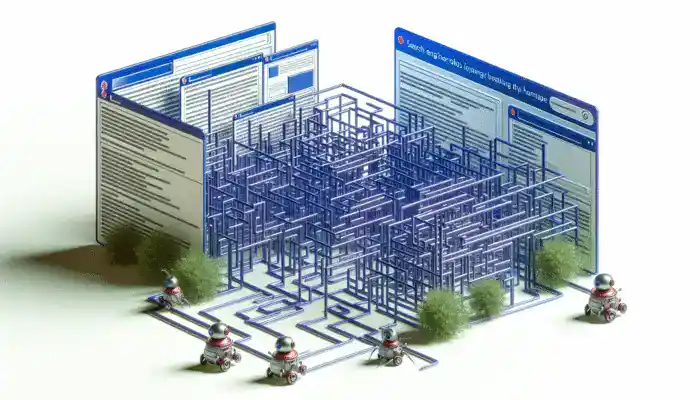Table of Contents
ToggleMaximize Your Website’s Performance with Strategic Internal Linking Techniques
Internal linking is a fundamental yet often underestimated aspect of a successful website strategy. By implementing a robust internal linking framework, you can significantly enhance your site’s user experience, improve your SEO performance, and increase the visibility of your content across search engines. Many website owners overlook the potential benefits of internal linking, leading to missed opportunities for engagement and traffic. This detailed guide explores the critical role of internal linking, addresses common challenges you may encounter, and offers actionable strategies to optimize your internal linking efforts. Additionally, we will introduce powerful tools like Link Ninja that can streamline this process and help you unlock your website’s full potential.
 Understanding the Critical Role of Internal Linking in Website Optimization
Understanding the Critical Role of Internal Linking in Website Optimization
1. Enhancing SEO and Streamlining Search Engine Crawling
Search engines, particularly Google, rely extensively on links to discover and index the vast array of content available online. Internal links act as a navigational blueprint for search engine crawlers, guiding them through your website while helping them understand the hierarchy and context of your pages. For instance, if your website includes a blog post titled “10 Ways to Improve Website Performance,” linking it to a comprehensive tutorial on caching plugins demonstrates a clear relationship between these topics. This interconnected structure allows search engines to assess relevance and rank your content more effectively, ultimately improving your site’s visibility in search results and driving more organic traffic.
2. Creating an Engaging and Seamless User Experience
When users visit your website, they typically seek valuable information, solutions, or services. Internal links play a vital role in guiding users through your content in a smooth manner. By effectively directing visitors to related topics, rather than allowing them to exit after viewing only one page, you create a more engaging experience that encourages exploration and reduces bounce rates. For example, in a fitness blog, a reader interested in “5 Benefits of Cardio Workouts” may also be curious about “The Best Shoes for Running.” By establishing internal links between such pages, you keep visitors engaged, satisfy their curiosity, and promote a richer, more rewarding user experience.
3. Effective Distribution of Page Authority Across Your Site
Pages that possess high authority can pass their “link juice” to other pages on your site through thoughtful internal linking strategies, which can significantly enhance your overall SEO performance. Imagine a high-ranking landing page that targets a competitive keyword; when you link from this page to a newer or less-recognized blog post, you help elevate the latter’s visibility and authority. This strategic distribution of page authority not only improves the ranking potential of your interconnected pages but also strengthens your website’s overall credibility and relevance in the eyes of search engines.
Overcoming Common Challenges in Implementing Internal Linking
1. Managing Time Constraints and Resource Limitations
Finding opportunities for internal linking can be a time-intensive task, especially for larger websites with extensive content libraries. Each new piece of content needs to be thoughtfully connected to existing pages, which can require a considerable amount of effort and resources. This hurdle can discourage even the most committed website owners from developing a well-structured internal linking strategy. Therefore, it is essential to adopt efficient methods for integrating links without overwhelming your workflow or sacrificing content quality.
2. Capitalizing on Missed Internal Linking Opportunities
Many websites fail to take advantage of valuable internal linking opportunities due to a lack of systematic approaches. For example, older blog posts may remain unlinked and hidden, despite containing relevant information that could enhance the value of current content. By regularly reviewing your website’s existing pages and integrating links to related articles, you can maximize the potential of your entire content library, ensuring that even past posts contribute to your site’s ongoing relevance, authority, and visibility.
3. Avoiding Overuse or Misapplication of Internal Links
While internal linking is beneficial, overloading a page with excessive or irrelevant links can confuse users and dilute your SEO advantages. Additionally, linking to the same page multiple times unnecessarily may come across as spammy to both visitors and search engines, leading to a poor user experience and potential penalties. Therefore, it is crucial to strike the right balance in your internal linking strategy to maintain credibility, provide genuine value to your audience, and enhance user engagement.
 Essential Strategies for Developing an Effective Internal Linking Structure
Essential Strategies for Developing an Effective Internal Linking Structure
1. Crafting Optimized Anchor Text for Clarity and Relevance
The anchor text—the clickable text within a hyperlink—should be descriptive and contextually relevant. Instead of using generic phrases like “click here,” opt for specific keywords that accurately reflect the linked content, such as “discover more about digital marketing strategies.” This practice not only enhances user understanding but also improves the SEO value of your links, making them more beneficial for both users and search engines alike.
2. Strategically Placing Links for Maximum User Engagement
Position your internal links where they can provide the greatest value to readers. Links should appear in contexts that naturally enhance the reader’s understanding or journey through your content. For instance, incorporating links within the body of your text, particularly in relevant sections, can guide users seamlessly and add much-needed context, ultimately enriching their experience and encouraging further exploration of your site.
3. Prioritizing Contextual Relevance in Your Linking Strategy
Ensure that the pages you are linking to are relevant to the context of the content. For example, linking a blog post about baking tips to an article on car maintenance lacks relevance and can undermine your site’s credibility. By focusing on contextual relevance, you can significantly enhance user experience and bolster your website’s authority in the eyes of search engines, leading to improved rankings and engagement.
Building a Comprehensive Internal Linking Strategy
1. Conducting a Thorough Audit of Your Current Internal Links
Start by assessing your website’s existing linking structure. Utilize tools such as Google Search Console or SEO platforms like Ahrefs to identify internal links and uncover gaps in your linking strategy. For example, check if your most visited pages connect to less prominent but equally valuable content, ensuring all parts of your site work together harmoniously to maximize visibility and user engagement.
2. Identifying High-Value Pages for Strategic Linking Opportunities
Identify which pages on your website possess the highest authority or attract significant traffic. These pages should serve as hubs, linking to related content that enriches the user’s journey. Additionally, ensure that other areas of your site link back to these high-value pages, reinforcing their importance and enhancing their overall visibility in search engine results, ultimately driving more traffic.
3. Establishing a Consistent Routine for Internal Linking
Internal linking should be an integral component of your content creation process. When you publish a new blog post, proactively seek 2 to 3 opportunities to link to relevant existing content. By integrating this practice into your workflow, you can continuously enhance your internal linking strategy, ensuring that your content remains interconnected and easily accessible to users, thereby improving overall site performance.
 Transform Your Internal Linking Process with Link Ninja
Transform Your Internal Linking Process with Link Ninja
Implementing an effective internal linking strategy can be a daunting task when done manually. This is where tools like Link Ninja come into play, simplifying the process and enhancing your overall strategy.
How Link Ninja Revolutionizes Your Internal Linking Approach:
- Automated Linking Suggestions
Link Ninja intelligently scans your content for bolded keywords and automatically recommends related pages, blogs, or products to link to, saving you valuable time and effort during the editing process. - Ensures Unique Links for Improved Content Relevance
The tool avoids the common issue of linking to the same URL multiple times within an article, ensuring that each link adds diversity and contextual relevance to your content. - Comprehensive Linking Across Various Content Types
Unlike basic linking tools, Link Ninja extends its capabilities beyond traditional posts to include pages and WooCommerce products, maximizing your internal linking opportunities throughout your entire site. - Efficiency in Time Management
With Link Ninja, you can focus on producing high-quality content while the tool handles the heavy lifting of identifying and inserting relevant links, significantly improving your workflow efficiency.
Successful Case Studies Demonstrating Effective Internal Linking Practices
Example 1: Strategic Linking in E-commerce Websites
An online store specializing in fitness equipment can effectively link a product page for yoga mats to an informative blog post titled “5 Yoga Poses for Beginners.” This strategic internal linking creates a seamless user journey, bridging informative content and transactional pages, which enhances user engagement and significantly boosts conversion rates.
Example 2: Interlinking Techniques for Educational Blogs
A website focused on digital marketing might interlink articles discussing “SEO Basics,” “Keyword Research,” and “Content Optimization.” Such connections guide readers through interconnected subjects, enriching their understanding while simultaneously improving each article’s search engine rankings, ultimately leading to increased traffic and authority.
 Expert Insights for Advanced Internal Linking Techniques
Expert Insights for Advanced Internal Linking Techniques
1. Utilizing Breadcrumb Navigation for Enhanced User Guidance
Breadcrumbs serve as a secondary navigation system that helps users track their location within your website. This feature not only enhances the internal linking structure but also provides an easy-to-follow trail, making it simpler for users to navigate back to previous pages or categories while improving overall user experience.
2. Leveraging Category Pages for Better Content Organization
Implementing category or hub pages for websites with extensive content can effectively consolidate related topics. For instance, a cooking website could create a category page for “Desserts” that links to individual recipes like “Chocolate Cake” and “Apple Pie,” allowing users to explore related content easily and enhancing the overall site structure.
3. Regularly Updating Internal Links to Maintain Content Freshness
As your website expands, it is crucial to revisit older posts to incorporate links to newer content. This practice keeps your site dynamic and interconnected, ensuring that all pages work together cohesively to enhance your content strategy and improve user engagement over time.
Future-Proofing Your Internal Linking Strategies for Ongoing Success
As search engines continue to evolve, internal linking will remain a cornerstone of effective SEO and user experience. Utilizing tools like Link Ninja will simplify the process, allowing you to concentrate on creating quality content while optimizing your internal linking strategy for maximum impact.
By prioritizing a well-thought-out internal linking approach, you can significantly enhance your website’s visibility, boost user engagement, and ultimately achieve your objectives—whether they involve improving search rankings, increasing conversions, or enhancing content discoverability.
Take Action Now
Internal linking is more than just an SEO tactic; it is essential for establishing a cohesive and user-friendly website. By adopting a strategic approach and leveraging tools like Link Ninja, you can ensure that every piece of content on your site contributes meaningfully to your goals. Start implementing these best practices today and watch your website’s performance, engagement metrics, and overall effectiveness soar.
The post Internal Linking Mastery: Unlock Your Website’s Potential appeared first on Ezi Gold.
















20 Comments
It’s fascinating how internal linking can often be the unsung hero of a website’s performance. I’ve seen firsthand how a few strategic links can guide users to discover more content they didn’t know they needed, keeping them engaged longer. For instance, on my blog about sustainable living, I implemented a few internal links to related articles, which not only helped my visitors find more relevant info but also boosted my search rankings.
You’ve touched on a key aspect of website structure that often gets overlooked. It’s interesting to see how such a simple strategy, like adding related links, can create a ripple effect in user experience. When visitors find themselves seamlessly led to content that enriches what they’re already reading, it not only helps them stay longer but also deepens their connection to your subject matter.
It’s great to hear about your personal experience with internal linking on your blog about sustainable living. That’s exactly the kind of impact these links can have, isn’t it? I think many website owners overlook the importance of guiding users through their content seamlessly. It’s like creating a little roadmap for your readers—it helps them navigate the journey you’ve crafted and often leads to unexpected gems of information they might not have discovered otherwise.
Internal linking really does seem to be one of those hidden gems in website optimization. I’ve been diving into my site analytics lately, and it’s eye-opening to see how simple changes can lead to noticeable improvements in both traffic and user engagement.
I’ve always found internal linking fascinating, especially how it can create a seamless flow for users navigating through a site. I remember when I first started focusing on this strategy; the increase in engagement metrics was pretty encouraging! One thing I’ve learned is that linking to relevant content not only helps with SEO but also keeps users on the site longer, which can really boost conversion rates.
It’s great to hear about your experience with internal linking! It’s interesting how something that seems simple on the surface can have such a profound impact on user behavior. When you start thinking about how users flow through a site, it’s almost like crafting a story where every link is a new chapter.
“I’m glad to hear you share the same enthusiasm for internal linking! If you’re interested in taking your strategy even further, check out this resource that dives deeper into effective techniques for enhancing user engagement and boosting conversions.”
https://ai.ezi.gold/copyscape
I’ve found your insights on internal linking particularly refreshing, as it’s an area many website owners seem to overlook despite its importance. It’s fascinating how something so fundamental can have such a profound impact on both user experience and search engine optimization. I’ve noticed in my own experience that when I strategically link related content on my site, users tend to spend more time navigating through articles, which enhances their engagement and keeps them coming back.
You raise an important point about the often-neglected impact of internal linking on SEO and user experience. It reminds me of the Balasubramanian et al. (2006) study, which highlighted how effective navigation directly influences site engagement. However, I wonder if there’s a risk of over-linking, where the focus shifts from meaningful context to just boosting link numbers. For instance, some e-commerce sites seem to clutter their pages with links, potentially distracting users rather than guiding them. It would be interesting to hear about best practices for balancing quantity and quality in this context, especially as user behavior evolves. The mention of tools like Link Ninja is also intriguing—technology is advancing rapidly, but do you think there’s a point where reliance on such tools could make necessary human oversight and strategy less intuitive?
You’ve touched on a crucial aspect of internal linking that often gets overlooked—the balance between enhancing user experience and avoiding link clutter. It’s true that over-linking can create confusion, especially on e-commerce sites where the goal is to guide users seamlessly to their next step. Clarity should always win over quantity.
Your exploration of internal linking shines a light on a crucial yet often overlooked area in website optimization. I’ve personally relied on strategic internal links to guide visitors through related content on my blog, and the impact on user engagement has been significant. It’s fascinating how a well-structured internal linking framework not only helps with SEO but also acts as a roadmap for users, offering them a richer experience.
You’ve nailed a really important aspect of website optimization. The way internal links serve as a guide for users is so enlightening. I’ve found that when I take the time to create a logical internal linking structure, it not only helps in terms of SEO but also creates a narrative flow that keeps readers engaged. It almost feels like curating an experience for them, leading them to discover more of what they might enjoy.
I’m glad you found the exploration of internal linking both enlightening and practical! It’s kind of like setting up little road signs for your readers saying, “Hey, if you liked that, you’ll love this!” It’s a way of playing tour guide in the vast museum that is your blog.
This is such a timely reminder about the importance of internal linking! I’ve always found it fascinating how something so straightforward can have such a profound impact on user experience and SEO. When I revamped my blog and focused on strategic internal links, I noticed a significant increase in page views and reader engagement.
It’s fascinating how much of a difference internal linking can make in navigating user experience and SEO! I’ve recently started to optimize my own website using strategized internal links and noticed a significant improvement in page views and user engagement. It’s almost like creating a guided tour for visitors, helping them discover content they might not have found otherwise.
Your exploration of internal linking resonates deeply, especially considering how it can be a game-changer for many website owners who tend to overlook its significance. It’s intriguing to think about how such a fundamental element can drive not only SEO but also user engagement.
It’s great to see your enthusiasm for internal linking; it really is one of those unsung heroes in the realm of website management. When we talk about driving SEO and enhancing user engagement, internal links often get overshadowed by more glamorous topics like keyword strategies or flashy graphics. But the truth is, they quietly hold a lot of power.
I’m glad you found the exploration of internal linking valuable! If you’re interested in diving deeper into strategies that can enhance both your SEO and user engagement, check out this helpful resource.
https://ai.ezi.gold/ninja
I appreciate how you highlighted the often-overlooked value of internal linking in website performance. It really reminds me of how critical it is to create a seamless navigation experience for users. For instance, I recently revamped my own blog by strategically linking related posts together, and I noticed not only an uptick in page views but also an improvement in how long visitors stayed on my site.
You’ve touched on an incredibly important yet often overlooked topic with your discussion on internal linking. It’s fascinating how something so fundamental can often fly under the radar for many website owners. In my experience, I’ve seen significant improvements in both user engagement and SEO metrics after revisiting my internal linking strategy.
I really appreciate this breakdown of internal linking. It’s something I’ve been digging into a lot lately, especially as I try to refine my own website strategy. When I first started focusing on SEO, I was more fixated on things like keyword research and backlinking, thinking those were the shiny objects that would attract traffic. But as I learned more about user experience and site navigation, it became clear just how crucial internal links are in keeping visitors engaged.
This exploration of internal linking techniques touches upon a crucial yet often overlooked aspect of web strategy. As someone who has navigated the ups and downs of optimizing websites, I can attest to the difference that a well-thought-out internal linking structure can make.